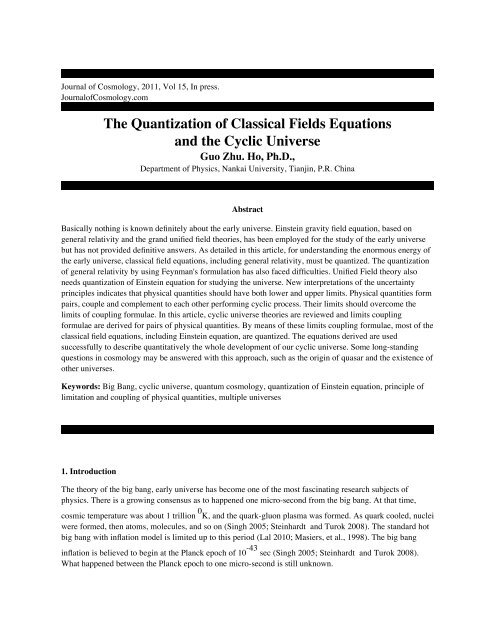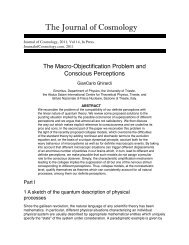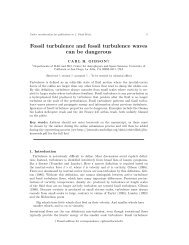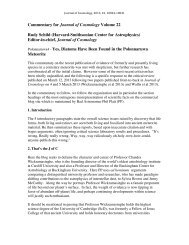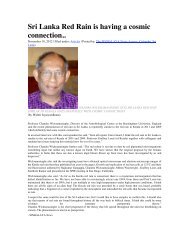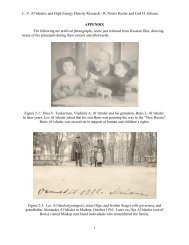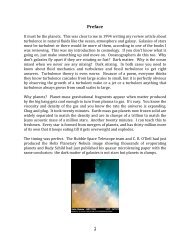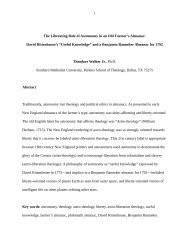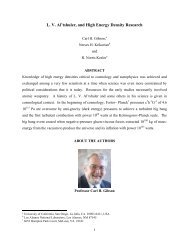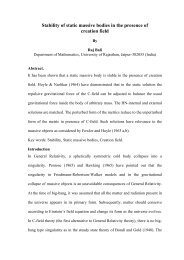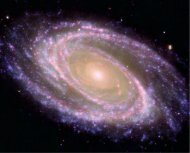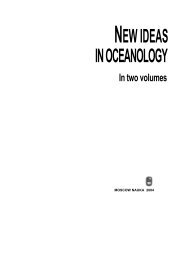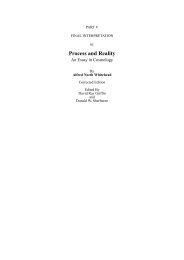The Quantization of Classical Fields Equations and the Cyclic ...
The Quantization of Classical Fields Equations and the Cyclic ...
The Quantization of Classical Fields Equations and the Cyclic ...
Create successful ePaper yourself
Turn your PDF publications into a flip-book with our unique Google optimized e-Paper software.
Journal <strong>of</strong> Cosmology, 2011, Vol 15, In press.<br />
Journal<strong>of</strong>Cosmology.com<br />
<strong>The</strong> <strong>Quantization</strong> <strong>of</strong> <strong>Classical</strong> <strong>Fields</strong> <strong>Equations</strong><br />
<strong>and</strong> <strong>the</strong> <strong>Cyclic</strong> Universe<br />
Guo Zhu. Ho, Ph.D.,<br />
Department <strong>of</strong> Physics, Nankai University, Tianjin, P.R. China<br />
Abstract<br />
Basically nothing is known definitely about <strong>the</strong> early universe. Einstein gravity field equation, based on<br />
general relativity <strong>and</strong> <strong>the</strong> gr<strong>and</strong> unified field <strong>the</strong>ories, has been employed for <strong>the</strong> study <strong>of</strong> <strong>the</strong> early universe<br />
but has not provided definitive answers. As detailed in this article, for underst<strong>and</strong>ing <strong>the</strong> enormous energy <strong>of</strong><br />
<strong>the</strong> early universe, classical field equations, including general relativity, must be quantized. <strong>The</strong> quantization<br />
<strong>of</strong> general relativity by using Feynman's formulation has also faced difficulties. Unified Field <strong>the</strong>ory also<br />
needs quantization <strong>of</strong> Einstein equation for studying <strong>the</strong> universe. New interpretations <strong>of</strong> <strong>the</strong> uncertainty<br />
principles indicates that physical quantities should have both lower <strong>and</strong> upper limits. Physical quantities form<br />
pairs, couple <strong>and</strong> complement to each o<strong>the</strong>r performing cyclic process. <strong>The</strong>ir limits should overcome <strong>the</strong><br />
limits <strong>of</strong> coupling formulae. In this article, cyclic universe <strong>the</strong>ories are reviewed <strong>and</strong> limits coupling<br />
formulae are derived for pairs <strong>of</strong> physical quantities. By means <strong>of</strong> <strong>the</strong>se limits coupling formulae, most <strong>of</strong> <strong>the</strong><br />
classical field equations, including Einstein equation, are quantized. <strong>The</strong> equations derived are used<br />
successfully to describe quantitatively <strong>the</strong> whole development <strong>of</strong> our cyclic universe. Some long-st<strong>and</strong>ing<br />
questions in cosmology may be answered with this approach, such as <strong>the</strong> origin <strong>of</strong> quasar <strong>and</strong> <strong>the</strong> existence <strong>of</strong><br />
o<strong>the</strong>r universes.<br />
Keywords: Big Bang, cyclic universe, quantum cosmology, quantization <strong>of</strong> Einstein equation, principle <strong>of</strong><br />
limitation <strong>and</strong> coupling <strong>of</strong> physical quantities, multiple universes<br />
1. Introduction<br />
<strong>The</strong> <strong>the</strong>ory <strong>of</strong> <strong>the</strong> big bang, early universe has become one <strong>of</strong> <strong>the</strong> most fascinating research subjects <strong>of</strong><br />
physics. <strong>The</strong>re is a growing consensus as to happened one micro-second from <strong>the</strong> big bang. At that time,<br />
cosmic temperature was about 1 trillion 0 K, <strong>and</strong> <strong>the</strong> quark-gluon plasma was formed. As quark cooled, nuclei<br />
were formed, <strong>the</strong>n atoms, molecules, <strong>and</strong> so on (Singh 2005; Steinhardt <strong>and</strong> Turok 2008). <strong>The</strong> st<strong>and</strong>ard hot<br />
big bang with inflation model is limited up to this period (Lal 2010; Masiers, et al., 1998). <strong>The</strong> big bang<br />
inflation is believed to begin at <strong>the</strong> Planck epoch <strong>of</strong> 10 -43 sec (Singh 2005; Steinhardt <strong>and</strong> Turok 2008).<br />
What happened between <strong>the</strong> Planck epoch to one micro-second is still unknown.
Some scientists have argued that <strong>the</strong> mass <strong>of</strong> prime particles should be infinite by Einstein equation (Joseph<br />
2010a,b). <strong>The</strong>refore, how can those prime particles attracted to each o<strong>the</strong>r so tightly into a point <strong>of</strong><br />
singularity, escape <strong>and</strong> exp<strong>and</strong> to form <strong>the</strong> universe? <strong>The</strong> reason this question has not been answered is that at<br />
<strong>the</strong> development <strong>of</strong> special relativity, <strong>the</strong> limitation <strong>of</strong> physical quantities was not considered. Einstein<br />
equation needs to be quantized. We shall discuss this in greater detail later in this paper.<br />
Physical quantities should have lower <strong>and</strong> upper limits (Ho, 2008). <strong>Equations</strong> <strong>of</strong> <strong>the</strong>se physical quantities<br />
should be quantized at <strong>the</strong>se environments <strong>of</strong> limits. It has been noted by L<strong>and</strong>au, Klein, <strong>and</strong> Pauli (Weber,<br />
1961) that quantized relativity would have to be considered in elementary particle <strong>the</strong>ory, at high energies.<br />
As P.G. Bergmann has remarked (Bergmann, et al., 1950), un-quantized general relativity cannot peacefully<br />
coexist with quantum <strong>the</strong>ory. Its quantization may affect, in a pr<strong>of</strong>ound way, our notions <strong>of</strong> space <strong>and</strong> time<br />
particularly in <strong>the</strong> realm <strong>of</strong> small dimensions (high energy). If a Feynman sum is carried out, over all<br />
metrics, <strong>the</strong> difficulties with <strong>the</strong> light cone may turn out to have measure zero. This indicates, unfortunately,<br />
that any quantization scheme which starts with a flat-space linear approximation will immediately have all <strong>the</strong><br />
divergences (Bergmann, et al., 1950). It means that Einstein gravity field equation may not be applied for <strong>the</strong><br />
study <strong>of</strong> <strong>the</strong> early universe. Indeed, it is only after <strong>the</strong> big bang <strong>and</strong> <strong>the</strong> creation <strong>of</strong> <strong>the</strong> first atoms, that<br />
physics can even be applied to this question, for up to this point, physics does not really exist.<br />
<strong>The</strong> o<strong>the</strong>r difficulty, already alluded to, is <strong>the</strong> "singularity." It has been argued that if <strong>the</strong>re was a singularity,<br />
this indicates <strong>the</strong> big bang was not <strong>the</strong> beginning, but a continuation (Joseph 2010a). How did a singularity<br />
first originate? One answer rests upon <strong>the</strong> quantum physics <strong>of</strong> black holes (Joseph 2010b) each <strong>of</strong> which can<br />
be considered a singularity <strong>of</strong> such compacted mass <strong>and</strong> gravity that space time becomes warped. However, it<br />
has also been <strong>the</strong>orized that energy <strong>and</strong> elementary particles are released when a black holes is formed, such<br />
that matter is recycled (Joseph 2010a,b). If this universe was created following <strong>the</strong> establishment <strong>of</strong> a<br />
singularity, <strong>the</strong>n <strong>the</strong> universe may be cyclic.<br />
Albert Einstein considered <strong>the</strong> possibility <strong>of</strong> an oscillating universe which sustains itself through cycles <strong>of</strong><br />
creation followed by a big crunch. In this model, <strong>the</strong> universe exp<strong>and</strong>s until slowed by <strong>the</strong> gravitational<br />
attraction <strong>of</strong> matter, causing it to collapse. According to Tolman (1934), this model fails to take into account<br />
<strong>the</strong> entropy problem as entropy would increases due to <strong>the</strong> Second law <strong>of</strong> <strong>the</strong>rmodynamics. Initially,<br />
successive cycles should grow longer <strong>and</strong> larger, with previous cycles growing shorter, culminating again in a<br />
Big Bang. If Einstein's cyclic model were correct, <strong>the</strong>n <strong>the</strong> cycles would eventually come to an end, as <strong>the</strong><br />
universe would be consumed by <strong>the</strong>rmodynamic heat death.<br />
Steinhardt <strong>and</strong> Turok (2001, 2002) have also proposed a cyclic universe by reformulating <strong>the</strong> st<strong>and</strong>ard hot<br />
big bang inflation model. <strong>The</strong>y have proposed an endless cyclic universe model (Steinhardt <strong>and</strong> Turok 2001,<br />
2002) where <strong>the</strong> universe comes into existence repeatedly over time. According to Steinhardt <strong>and</strong> Turok<br />
(2002), <strong>the</strong> universe exp<strong>and</strong>s after each big bang, which prevents entropy from building up. However, <strong>the</strong><br />
Steinhardt <strong>and</strong> Turok (2002), model requires <strong>the</strong> existence <strong>of</strong> colliding branes <strong>and</strong> a variety <strong>of</strong> forces which<br />
exist between <strong>the</strong> branes; <strong>of</strong> which <strong>the</strong>re is no evidence.<br />
Baum <strong>and</strong> Frampton (2007a,b) have also proposed a cyclic universe which depends on hypo<strong>the</strong>tical forces<br />
<strong>and</strong> phantom energies which maintains each cycle <strong>and</strong> regulates <strong>the</strong> pressure <strong>and</strong> density <strong>of</strong> each expansion<br />
<strong>and</strong> collapse. In this model, a septillionth (or less) <strong>of</strong> a second before <strong>the</strong> would-be Big Rip, everything<br />
begins to collapse except for a small patch <strong>of</strong> <strong>the</strong> universe which is devoid <strong>of</strong> elementary particles <strong>and</strong><br />
consists only <strong>of</strong> dark energy. Thus <strong>the</strong>re is no entropy. <strong>The</strong>refore, each universe starts as empty, <strong>and</strong> as it<br />
collapses <strong>the</strong>re is no matter which would cause it to prematurely spring back into existence before collapsing<br />
<strong>and</strong> beginning again as a Big Bang. <strong>The</strong> problem <strong>of</strong> <strong>the</strong> second law <strong>of</strong> <strong>the</strong>rmodynamics is avoided.
Sir Roger Penrose (Gurzadyan <strong>and</strong> Penrose 2010) argues that <strong>the</strong> universe began in a very low state <strong>of</strong><br />
entropy. Instead <strong>of</strong> an empty cyclic universe, this universe began under conditions where <strong>the</strong>re was a high<br />
degree <strong>of</strong> order which gave rise to <strong>the</strong> complexity <strong>of</strong> <strong>the</strong> modern day cosmos. <strong>The</strong> low state <strong>of</strong> initial<br />
entropy indicates that <strong>the</strong> present universe was not <strong>the</strong> beginning, but is part <strong>of</strong> a cyclical chain with matter<br />
left over as each universe returns to a state <strong>of</strong> low entropy. In this model, <strong>the</strong> universe exp<strong>and</strong>s into eventual<br />
nothingness such that even black holes disintegrate, <strong>and</strong> <strong>the</strong> resulting highly ordered universe collapses into a<br />
singularity <strong>and</strong> <strong>the</strong> cycle begins again.<br />
Gurzadyan <strong>and</strong> Penrose (2010) claim <strong>the</strong>y have found evidence <strong>of</strong> <strong>the</strong> previous universe in <strong>the</strong> cosmic<br />
microwave background. <strong>The</strong>y believe <strong>the</strong>y have identified clear concentric circles within <strong>the</strong> radiation with<br />
temperature lower than those in o<strong>the</strong>r areas <strong>of</strong> <strong>the</strong> cosmos. Joseph (2010a) believes <strong>the</strong>se concentric circles in<br />
fact surround galaxy-in-mass black holes. Gurzadyan <strong>and</strong> Penrose (2010) believes <strong>the</strong>se are spherical ripples<br />
were instead created by colliding black holes in <strong>the</strong> previous universe. Key to this model is <strong>the</strong> belief that all<br />
particles will eventually lose <strong>the</strong>ir mass, <strong>the</strong>reby triggering <strong>the</strong> end <strong>of</strong> this universe.<br />
Thus, central to <strong>the</strong> <strong>the</strong>ory <strong>of</strong> a cyclic universe is <strong>the</strong> idea <strong>of</strong> <strong>the</strong> "big crunch"; i.e. a universe which exp<strong>and</strong>s,<br />
<strong>the</strong>n slow, <strong>the</strong>n collapses into a big crunch singularity, only to explode outward in yet ano<strong>the</strong>r big bang, <strong>and</strong><br />
<strong>the</strong>n <strong>the</strong> expansion followed by collapse repeats itself. If <strong>the</strong> cyclic models <strong>of</strong> <strong>the</strong> cosmos are accurate, <strong>the</strong>n it<br />
can be deduced that <strong>the</strong>re have been infinite big bangs; a cycle which repeats itself for all eternity.<br />
However, if <strong>the</strong> universe is cyclic, this raises yet o<strong>the</strong>r questions. Was <strong>the</strong> previous universe like this one?<br />
Does a cyclic universe mean that each universe is exactly like <strong>the</strong> ones that came before?<br />
Although we cannot answer this latter question, we are provided a number <strong>of</strong> clues about <strong>the</strong> beginning <strong>of</strong><br />
this universe. <strong>The</strong> cyclic model <strong>of</strong> Joseph (2010a,b) relies on quantum physics, including <strong>the</strong> uncertainty<br />
principle (Heisenberg 1930, 1955). According to <strong>the</strong> uncertainty principle (Heisenberg 1930, 1955), energy,<br />
time, momentum, <strong>and</strong> length must have both lower <strong>and</strong> upper limits. It is already known that energy has<br />
lower limits. Does energy also have an upper limit? It is possible time also has upper <strong>and</strong> lower limits? If so,<br />
this means <strong>the</strong> big bang cannot start from zero.<br />
In a cyclic universe, <strong>the</strong>re does exist a Planck time at <strong>the</strong> beginning <strong>of</strong> each big bang. What are <strong>the</strong> upper<br />
limits <strong>of</strong> time <strong>and</strong> length? If <strong>the</strong> length has upper limit, <strong>the</strong>n our universe cannot exp<strong>and</strong> to infinity <strong>and</strong> it will<br />
collapse. Each universe is finite. Ano<strong>the</strong>r significant meaning <strong>of</strong> <strong>the</strong> uncertainty principle is that physical<br />
quantities form pairs (Heisenberg 1930, 1955). <strong>The</strong> limits <strong>of</strong> <strong>the</strong>se pairs couple <strong>and</strong> complement each o<strong>the</strong>r to<br />
perform an everlasting cyclic processes. If we combine <strong>the</strong>se principles <strong>and</strong> possibilities, this also supports <strong>the</strong><br />
cyclic big bang model <strong>of</strong> our universe.<br />
Several limits coupling formulae similar to uncertainty principles are derived in this paper for a number <strong>of</strong><br />
o<strong>the</strong>r physical quantity pairs. By means <strong>of</strong> <strong>the</strong>se formulae, many <strong>of</strong> <strong>the</strong> classical field equations can be<br />
quantized <strong>and</strong> derived equations derived can now be applied for physics at <strong>the</strong> extreme environments in<br />
cosmology. As detailed in this paper, by <strong>the</strong>rmal energy <strong>and</strong> temperature limits coupling formula, a quantum<br />
<strong>the</strong>rmal dynamics equation is obtained. It reduces to Planck equation exactly, as <strong>the</strong>rmal energy reaches its<br />
lower limit. It can also describe <strong>the</strong> variation <strong>of</strong> <strong>the</strong>rmal energy <strong>and</strong> temperature <strong>of</strong> our universe during its<br />
whole cyclic process.<br />
Special relativity <strong>the</strong>ory is somewhat related to <strong>the</strong> physical quantities <strong>and</strong> velocity limits <strong>of</strong> coupling<br />
processes. It is found that by ordinary Lorentz transformations all <strong>the</strong> physical quantities will increase as<br />
velocity increases. <strong>The</strong>se findings are different from that obtained from <strong>the</strong> physical quantities <strong>and</strong> velocity<br />
limits coupling formulae; <strong>the</strong>se give results showing that all <strong>the</strong> physical quantities decrease with velocity.<br />
<strong>The</strong> discrepancy may be that in <strong>the</strong>ir derivations from special relativity, <strong>the</strong> limitation <strong>of</strong> physical quantities
was not considered. <strong>The</strong> equation obtained from limits coupling formulae may be considered as <strong>the</strong><br />
quantized special relativity equations.<br />
However <strong>the</strong> result from length <strong>and</strong> velocity limits coupling formula gives exactly <strong>the</strong> same as Lorentz<br />
contraction principle. Why this is so? Lorentz used a second version <strong>of</strong> <strong>the</strong> Lorentz transformation in his<br />
derivation. By this version he constructed his famous principle. Lorentz considered dx <strong>and</strong> dt instead<br />
<strong>of</strong> x <strong>and</strong> t. This means that <strong>the</strong> limitations are taken into account. Coexistence is also considered. <strong>The</strong>se<br />
two are exactly what required by limits coupling formula. That is why Lorentz contraction principle is<br />
actually quantized <strong>and</strong> has <strong>the</strong> same result from limits coupling formula. This result will be discussed<br />
later in detail.<br />
2. Significant Meanings <strong>and</strong> New Interpretation <strong>of</strong> Uncertainty Principles<br />
<strong>The</strong> uncertainty principle <strong>of</strong> (1) does not only require that momentum has lower limit, it requires p <strong>and</strong> r<br />
having both lower <strong>and</strong> upper limits. <strong>The</strong>y cannot be zero or infinity.<br />
(1) is usually changed into<br />
∆p∆r ~ h (1)<br />
dp dr ~ h or dp ~ ih/dr (2)<br />
(2) has been introduced into classical field equation <strong>and</strong> obtained quantum mechanics which has been<br />
successfully used under lower energy limit cases. <strong>The</strong> meaning <strong>of</strong> <strong>the</strong> delta's in (1) are not clear or uncertain.<br />
However, <strong>the</strong> differentials dp <strong>and</strong> dr do have clear meanings. In calculus, <strong>the</strong>y mean taking<br />
limits. So (2) may be written as<br />
pmax . rmin = pmin . rmax = h (3)<br />
This requires that <strong>the</strong> limits <strong>of</strong> <strong>the</strong> pair will couple <strong>and</strong> complement to each o<strong>the</strong>r to perform cyclic<br />
process. When one quantity reaches its lower limit, its partner will be at its upper limit <strong>and</strong> vice versa.<br />
<strong>The</strong>ir product must equal to a universal constant.<br />
Ano<strong>the</strong>r strong argument for supporting <strong>the</strong> uncertainty principle is <strong>the</strong> meaning <strong>of</strong> wave function. Wave<br />
function does not give clear location <strong>of</strong> <strong>the</strong> particle. It appears to give only probability <strong>of</strong> where <strong>the</strong><br />
particle locates. <strong>The</strong> location <strong>of</strong> <strong>the</strong> particle is still uncertain. However, as we know from special<br />
relativity that for particle in motion, some <strong>of</strong> its mass will change into radiation. That means particle has<br />
dual properties, particle property <strong>and</strong> wave property. Wave function describes both <strong>the</strong>se dual properties.<br />
It does not mean uncertain <strong>of</strong> <strong>the</strong> particle location.<br />
By writing uncertainty principles into limits coupling formulae does not only avoid its misleading, it<br />
reveals that limits coupling formulae are fundamental rules <strong>of</strong> nature for ensuring that physical<br />
quantities performing everlasting cyclic processes to make stable structures for atoms <strong>and</strong> universes.
Figure 1.<br />
To make it clearer to underst<strong>and</strong>, let us consider a simple case. An electron circulates around a proton,<br />
or a hydrogen atom. P <strong>and</strong> r cann ot be zero. According to (1), p <strong>and</strong> r must have both lower <strong>and</strong> upper<br />
limits. <strong>The</strong>ir limits satisfy (3). As shown in Fig. 1, let us consider <strong>the</strong> electron starts from <strong>the</strong> point<br />
where r is rmin <strong>and</strong> p is pmax . <strong>The</strong>n <strong>the</strong> electron will move, r increases <strong>and</strong> p decreases according to<br />
<strong>the</strong> quantum mechanics equation. However, r <strong>and</strong> p cannot be infinity. Electron will reach ano<strong>the</strong>r point<br />
at rmax <strong>and</strong> pmin. <strong>The</strong>n it will turn back, r decreases <strong>and</strong> p increases until it reaches <strong>the</strong> point where<br />
it started. A closed orbit is completed. (1) <strong>and</strong> (2) ensure that <strong>the</strong> electron accomplishes a closed orbit<br />
<strong>and</strong> stable atomic structure possible.<br />
Similarly, (4) has <strong>the</strong> same meaning for energy <strong>and</strong> time. For making <strong>the</strong> meaning <strong>of</strong> (3) <strong>and</strong> (4) more<br />
clearly <strong>and</strong> avoiding controversy, <strong>the</strong>y are named limits coupling formulae.<br />
3. Limits Coupling Formulae<br />
Emax .tmin =Emin .tmax = h (4)<br />
3.1 Momentum <strong>and</strong> Length Limits Coupling Formula.<br />
In <strong>the</strong> research <strong>of</strong> quantization <strong>of</strong> gravitational field, people found a quantity having <strong>the</strong> dimension <strong>of</strong> length.<br />
It can be expressed purely by universal constants.<br />
L = (hG/c 3 ) 1/2 ∼ 10 -33 cm<br />
It was found much too small to be directly related to elementary particle dimensions known at that time. This<br />
length is also known later as Planck length or length at Planck epoch. It will be shown later that this is just <strong>the</strong><br />
lower limit <strong>of</strong> length <strong>of</strong> our universe or <strong>the</strong> radius <strong>of</strong> our universe at its birth.<br />
3.2 Energy <strong>and</strong> Time Limits Coupling Formula.<br />
L<strong>and</strong>au in his research on <strong>the</strong> quantization <strong>of</strong> general relativity, found an energy which reaches up to 10 19<br />
Bev (L<strong>and</strong>au, 1955). Is this <strong>the</strong> highest energy <strong>of</strong> our universe? Yes. It is. It will be shown later that it<br />
is just <strong>the</strong> energy <strong>of</strong> <strong>the</strong> prime quanta emitted at big bang. Actually this is just what L<strong>and</strong>au was<br />
looking for by his quantization <strong>of</strong> general relativity <strong>the</strong>ory. Unfortunately, by that time <strong>the</strong> big bang was<br />
not discovered yet.<br />
If this is <strong>the</strong> upper limit <strong>of</strong> energy <strong>of</strong> our universe, <strong>the</strong>n by (4) <strong>the</strong> shortest limit <strong>of</strong> time <strong>of</strong> our universe<br />
will be 10 -43 seconds, <strong>the</strong> time <strong>of</strong> Planck epoch or <strong>the</strong> time <strong>of</strong> initial singularity. Within this interval it is<br />
believed that <strong>the</strong> law <strong>of</strong> physics is useless in explaining what happened <strong>and</strong> no one knows how space<br />
time <strong>and</strong> matter behaved under <strong>the</strong>se extreme circumstances. Time is not what we believed early,<br />
which has no beginning <strong>and</strong> is endless. We know now that this initial singularity is just <strong>the</strong> lower limit <strong>of</strong>
time <strong>of</strong> our universe. Our universe has a beginning. It starts at big bang, about 14 billion years ago.<br />
Time also has both lower <strong>and</strong> upper limits. Time <strong>and</strong> energy are conjugate partners. When a system<br />
reaches <strong>the</strong> upper energy limit as at big bang, its lifetime will be exceedingly short <strong>and</strong> <strong>the</strong> system will<br />
explode. If <strong>the</strong>re is no physical process, it is no meaning talking about time.<br />
3.3 Why Will Our Universe Not Exp<strong>and</strong> to Infinity?<br />
It is believed that <strong>the</strong> big bang resulted in an expansive force which is influenced by dark matter, dark<br />
energy, <strong>and</strong> gravity. <strong>The</strong>se forces have been formalized as <strong>the</strong> Hubble constant:<br />
H0=v/r=f(d)<br />
where d is <strong>the</strong> density <strong>of</strong> <strong>the</strong> universe. From <strong>the</strong> Hubble constant one can find a critical density d c. If<br />
<strong>the</strong> density observed <strong>of</strong> <strong>the</strong> present universe is smaller than d c, <strong>the</strong> universe will exp<strong>and</strong>. Now it is found<br />
that <strong>the</strong> currently estimated d is smaller than d c. This may be one <strong>of</strong> <strong>the</strong> reasons that our universe is<br />
exp<strong>and</strong>ing. Even though <strong>the</strong> density <strong>of</strong> <strong>the</strong> universe will become smaller, <strong>the</strong> critical density will also<br />
become smaller. If correct, <strong>the</strong>n <strong>the</strong> universe will exp<strong>and</strong> forever to infinity. Hubble's law is perfectly true<br />
in some ways. Our universe is exp<strong>and</strong>ing <strong>and</strong> predictions about <strong>the</strong> age <strong>of</strong> our universe are also<br />
reasonable. However, as <strong>the</strong> universe exp<strong>and</strong>s all <strong>the</strong> physical quantities involved, p, r, E <strong>and</strong> t, will<br />
reach <strong>the</strong>ir extremes. <strong>The</strong>y should satisfy <strong>the</strong> limits coupling formulae. None <strong>of</strong> <strong>the</strong>m can be zero or<br />
become infinity. That means that <strong>the</strong> case needs to be treated by quantized gravity field equations; <strong>and</strong><br />
this means our universe will have a cyclic structure similar to atomic structure.<br />
3.4 <strong>The</strong>rmal Energy <strong>and</strong> Temperature Limits Coupling Formula <strong>and</strong> Planck Equation<br />
Let us consider some more major physical quantities. <strong>The</strong> <strong>the</strong>rmal energy <strong>of</strong> a subject will vary as its<br />
temperature changes. In this case, energy increases as temperature rising. We may form a limits coupling<br />
formula for this conjugate pair as shown in equation<br />
dE/dT = k (5)<br />
where k is Boltzmann constant. For satisfying (5), E <strong>and</strong> T can also not be zero or infinity. Now, it is<br />
a ratio <strong>of</strong> <strong>the</strong> limits, instead <strong>of</strong> product. It is <strong>the</strong> ratio approaching a universal constant.<br />
Emax Tmax<br />
↔ Emin<br />
Tmin<br />
↔ k (6)<br />
In this case, <strong>the</strong> limits <strong>of</strong> <strong>the</strong> conjugate pair E <strong>and</strong> T do not complement to each o<strong>the</strong>r. It is <strong>the</strong> ratio<br />
varies. When <strong>the</strong> ratio <strong>of</strong> E <strong>and</strong> T reaches a fixed constant <strong>and</strong> cannot proceed any fur<strong>the</strong>r, something<br />
will happen to reverse <strong>the</strong> process. For deriving an equation describing how <strong>the</strong>rmal energy changes with<br />
temperature, we may directly solve <strong>the</strong> simple differential equation (5).<br />
Let us consider a free molecular <strong>the</strong>rmal expansion case. Since it is <strong>the</strong> ratio E/kT varies <strong>and</strong> <strong>the</strong> ratio should<br />
be considered as <strong>the</strong> integration variable, x = E/kT. Considering a cooling process, <strong>the</strong> energy decreases as<br />
temperature reaches its lower<br />
x<br />
dE<br />
dx<br />
∫ = ∫<br />
0<br />
( E)<br />
dx<br />
E<br />
E<br />
dE<br />
E<br />
With <strong>the</strong> application <strong>of</strong> a known indefinite integral (Courant, 1937a)<br />
x<br />
y y = e<br />
x<br />
∫ ′<br />
<strong>The</strong> integration <strong>of</strong> equation (7) gives<br />
e x<br />
= ln E<br />
0<br />
E<br />
(8)<br />
(7)
(8) may be quantization <strong>of</strong> <strong>the</strong>rmal dynamic. ln E0/E can be exp<strong>and</strong>ed into a series (Lorenzen, 1971)<br />
lnξ<br />
=<br />
i−1<br />
i<br />
( −1)<br />
( ξ −1)<br />
, ξ −1<br />
< 1<br />
∑<br />
i<br />
In our case, ξ = E0/E, When E approaches E0, we can consider only <strong>the</strong> first order <strong>of</strong> <strong>the</strong> terms<br />
ln E = 1−<br />
E E . Equation (8) gives<br />
E0 0<br />
E kT<br />
E = E0<br />
( e −1)<br />
(9)<br />
<strong>The</strong>n we obtain a very interesting result. Equation (9) is exactly <strong>the</strong> same as Planck obtained for average<br />
energy per particle at equilibrium, by assuming only discrete energy values or quanta in classical methods <strong>of</strong><br />
statistical mechanics. (9) works fine under lower limit circumstance. (8) should work under both extreme<br />
lower <strong>and</strong> upper environments for <strong>the</strong>rmal energy <strong>and</strong> temperature. Equation (8) describes how energy varies<br />
with temperature in <strong>the</strong> whole cyclic process <strong>of</strong> <strong>the</strong> gas expansion model <strong>of</strong> our universe as shown in Fig. 2.<br />
From this figure a rough estimation <strong>of</strong> <strong>the</strong> lower limit <strong>of</strong> <strong>the</strong> <strong>the</strong>rmal energy <strong>of</strong> our universe is obtained. Emin<br />
= 10 -33 ev.<br />
E Emax max<br />
Energy<br />
E min<br />
T min<br />
= k<br />
Figure 2.<br />
Once we know <strong>the</strong> lower limit <strong>of</strong> energy, from (6) <strong>the</strong> lower limit <strong>of</strong> <strong>the</strong> temperature <strong>of</strong> <strong>the</strong> universe will be<br />
Tmin = 10 -29 0 K. From (2.4) <strong>the</strong> life time <strong>of</strong> our universe or tmax will be 10 11 years. As we know that <strong>the</strong> age <strong>of</strong><br />
our universe now is about 10 10 years, so our universe is still young. Of course <strong>the</strong> estimation from <strong>the</strong> sketch<br />
<strong>of</strong> <strong>the</strong> plot is very rough, even <strong>the</strong> order <strong>of</strong> magnitude may be questionable.<br />
3.5 Limits Coupling Formulae <strong>and</strong> Special Relativity <strong>Equations</strong><br />
E<br />
T<br />
min<br />
min<br />
k<br />
Temperature<br />
T max<br />
By <strong>the</strong> <strong>the</strong>ory <strong>of</strong> relativity, it has been found that physical quantities, length, time <strong>and</strong> mass will change as<br />
<strong>the</strong>ir velocity increasing. Famous Lorentz contraction principle, time dilation principle <strong>and</strong> Einstein equation<br />
were discovered.<br />
From <strong>the</strong> point <strong>of</strong> view <strong>of</strong> <strong>the</strong> principle <strong>of</strong> limitation <strong>and</strong> coupling <strong>of</strong> major physical quantities, any one <strong>of</strong><br />
<strong>the</strong>se physical quantities <strong>and</strong> velocity may form a coupling pair, if a limits coupling formula can be<br />
E<br />
T<br />
max<br />
max<br />
= k
constructed for this pair. By solving this formula, it can also show how that physical quantity will change as<br />
its velocity.<br />
3.6 Length <strong>and</strong> Velocity Limits Coupling Formula <strong>and</strong> Lorentz Contraction Principle<br />
Let us consider that length <strong>and</strong> velocity form a coupling pair. A length <strong>and</strong> velocity limits coupling formula<br />
may be constructed for l <strong>and</strong> v as shown in equation<br />
dlv<br />
= c (10)<br />
dl<br />
Here lv may be considered as a physical quantity, like p = mv, in a physical process where m does not<br />
change. It may be called moment. It is now <strong>the</strong> ratio <strong>of</strong> moment <strong>and</strong> length instead <strong>of</strong> product <strong>of</strong><br />
<strong>the</strong>se two physical quantities equal to a constant c. c is <strong>the</strong> velocity <strong>of</strong> light which may be<br />
considered ano<strong>the</strong>r universal constant besides h <strong>and</strong> k. We also tried to obtain some equation<br />
describing <strong>the</strong> variation <strong>of</strong> length with <strong>the</strong> changing <strong>of</strong> velocity from (10) by direct integration<br />
dv<br />
v + = c (11)<br />
dl<br />
Because it is a ratio, a very simple differential equation appears. Equation (11) can be integrated<br />
directly by indefinite integrals.<br />
( dl + dv cdl (12)<br />
dv dl<br />
∫ v ) dv ∫ l(<br />
) dl = ∫<br />
This differential equation can be solved by using a known improper integral formula (Courant, 1937b).<br />
b<br />
ξ<br />
b<br />
∫ f ( x)<br />
φ ( x)<br />
dx = φ(<br />
a)<br />
∫ f ( x)<br />
dx + φ(<br />
b)<br />
a<br />
a ∫ f ( x)<br />
dx<br />
ξ<br />
Let us consider a subject with length l0 <strong>and</strong> initial velocity vi accelerates to a final maximum velocity c.<br />
During <strong>the</strong> process, length will change with its velocity <strong>and</strong> reaches lf. Applying <strong>the</strong> integral formula with <strong>the</strong><br />
initial <strong>and</strong> final conditions fixed as, for <strong>the</strong> first integral, f ( x)<br />
= v , Φ ( x ) = dl dv , according to our<br />
interpretation, i v l a Φ ( ) = 0 , Φ ( b) = l f c <strong>and</strong> for <strong>the</strong> second integral, f ( x)<br />
= l , Φ ( x ) = dv dl ,<br />
Φ ( a) = vi<br />
l0<br />
, Φ ( b ) = c l f . l <strong>and</strong> v should have both lower <strong>and</strong> upper limits. l <strong>and</strong> v form a conjugate pair.<br />
<strong>The</strong>ir limits must satisfy<br />
lmax • vmin<br />
In <strong>the</strong> present case<br />
= lmin<br />
• vmax<br />
(13)<br />
l f vi<br />
= l0c<br />
Under this condition, <strong>the</strong> differential equation will give a result as shown in equation (14)<br />
l −<br />
(14) agrees with Lorentz contraction principle exactly.<br />
2 2 1/<br />
2<br />
= l0<br />
( 1 v c ) (14)<br />
3.7 Time <strong>and</strong> Velocity Limits Coupling Formula <strong>and</strong> Time Dilation Principle<br />
Time <strong>and</strong> velocity may also form a coupling pair. A similar time <strong>and</strong> velocity limits coupling formula may be<br />
constructed as<br />
ds dvt<br />
= = c (15)<br />
dt dt<br />
Ano<strong>the</strong>r simple differential equation is obtained
v + t dv = c (16)<br />
dt<br />
This differential equation (16) is similar to (11). It can be integrated by <strong>the</strong> same procedures as what we<br />
do for (11) <strong>and</strong> obtain (17).<br />
t −<br />
2 2 1/<br />
2<br />
= t0<br />
( 1 v c ) (17)<br />
It is different from <strong>the</strong> time dilation principle. <strong>The</strong> discrepancy may because that in its derivation <strong>of</strong><br />
special relativity, <strong>the</strong> limitation <strong>of</strong> physical quantities was not considered. (17) may be considered as<br />
quantization <strong>of</strong> time dilation principle equation.<br />
3.8 Mass <strong>and</strong> Velocity Limits Coupling Formula <strong>and</strong> Einstein Equation<br />
Mass <strong>and</strong> velocity may also form a coupling pair <strong>and</strong> similar limits coupling formula is composed as shown<br />
in (18)<br />
∆ p / ∆m<br />
→ c (18)<br />
Here p= mv. A simple differential equation will be obtained. Integrating it by similar procedures as above,<br />
one gets (19)<br />
2 2 1/<br />
2<br />
m = m0<br />
( 1−<br />
v c ) (19)<br />
This equation is also different from what Einstein derived from relativity.<br />
m0<br />
m = (20)<br />
2 2 1/<br />
2<br />
( 1−<br />
v c )<br />
<strong>The</strong> equation (19) does also show that velocity cannot be greater than <strong>the</strong> velocity <strong>of</strong> light, which has<br />
shown in Einstein’s relativity <strong>the</strong>ory. However, in (19) as velocity starts from rest <strong>and</strong> reaches to c, <strong>the</strong><br />
mass decreases from 0 m to zero, instead <strong>of</strong> increasing from m0 to infinity by Einstein equation in (20).<br />
Actually, what happens in reality is that <strong>the</strong> mass disappears when its velocity reaches c. <strong>The</strong> mass is<br />
2<br />
transformed into radiation. At <strong>the</strong> end <strong>of</strong> <strong>the</strong> process, <strong>the</strong> total kinetic energy lost will be 1<br />
2 m 0c<br />
. As we<br />
know, <strong>the</strong> kinetic energy has been transferred to radiation. Particle annihilation generally happens in pairs.<br />
That gives<br />
E = moc 2 (21)<br />
It is ano<strong>the</strong>r Einstein’s famous mass <strong>and</strong> energy exchange formula.<br />
Electron annihilation <strong>and</strong> pair production <strong>of</strong> electron with positron by radiation have been observed in <strong>the</strong><br />
laboratories. Only <strong>the</strong> rest mass <strong>of</strong> electron was involved in <strong>the</strong>se mass <strong>and</strong> energy conversion processes. No<br />
indication <strong>of</strong> raising <strong>the</strong> mass <strong>of</strong> electron or energy beyond m was observed.<br />
Tolman in his book <strong>of</strong> relativity <strong>the</strong>ory (Tolman, 1934) was able to derive from Einstein equation <strong>the</strong> total<br />
kinetic energy <strong>of</strong> a particle <strong>of</strong> rest mass m 0 moving with velocity v<br />
m c<br />
( 1−<br />
v c<br />
2<br />
0c<br />
2<br />
E = 0<br />
2 2<br />
2<br />
− m c<br />
1 2 o (22)<br />
)<br />
which reduces as velocity small compared with that <strong>of</strong> light, to <strong>the</strong> familiar Newtonian expression<br />
2<br />
E = 1<br />
2 m0v<br />
<strong>The</strong>refore Einstein equation works fine under ordinary condition as on astrophysics.<br />
However, it was not possible to show that as <strong>the</strong> velocity reaches c, (22) reduced to (21). As pointed<br />
out in <strong>the</strong> book, actually, (21) was not derived but postulated.
Since according to (19) mass decreases with increasing velocity, (22) should be written as (23)<br />
E −<br />
2 2 2 2 1 2<br />
= m0<br />
c − m0c<br />
( 1 v c ) (23)<br />
If (19) is used instead <strong>of</strong> (20) for m as shown in (23), <strong>the</strong>n as <strong>the</strong> velocity reaches c, (23) does reduce to<br />
(21) naturally. As v is small, (23) also reduces to E =½ m0v 2 . That means (19) works under both ordinary<br />
<strong>and</strong> extreme conditions. It seems that <strong>the</strong> cause <strong>of</strong> discrepancy between (19) <strong>and</strong> (20) might be that<br />
in <strong>the</strong> derivation <strong>of</strong> (20) <strong>the</strong> limitation <strong>of</strong> physical quantities could not be taken into consideration at<br />
that time (Ho, 2008). (19) may be considered as quantization <strong>of</strong> Einstein equation.<br />
3.9 Why Only Lorentz Contraction Principle Agree with <strong>the</strong> Limits Coupling Formula Result?<br />
Tolman (1934) shows in his book that <strong>the</strong>re are two versions <strong>of</strong> Lorentz transformation equations. <strong>The</strong><br />
original version by Lorentz <strong>and</strong> Fitzgerald gives<br />
, ,<br />
( x + vt )<br />
, ( x − vt)<br />
x = <strong>and</strong> x =<br />
2 2 1/<br />
2<br />
2 2 1/<br />
2<br />
( 1−<br />
v c )<br />
( 1−<br />
v c )<br />
However, in <strong>the</strong> consideration <strong>of</strong> <strong>the</strong> transformation equations for spatial <strong>and</strong> temporal intervals dx <strong>and</strong><br />
dx’ instead <strong>of</strong> x <strong>and</strong> x’, also take coincidence into consideration, Lorentz obtained ano<strong>the</strong>r version<br />
dx −<br />
, 2 2 1/<br />
2<br />
= dx ( 1 v c ) <strong>and</strong><br />
,<br />
2 2<br />
dx = dx(<br />
1−<br />
v c<br />
By this second version, <strong>the</strong>se two situations are now symmetrical <strong>and</strong> in entire agreement. In both cases, a<br />
stick measures shorter in <strong>the</strong> ratio (1-v 2 /c 2 ) 1/2 : 1. It is <strong>the</strong>n called Lorentz contraction. <strong>The</strong> result differs from<br />
<strong>the</strong> contraction originally postulated by Lorentz <strong>and</strong> Fitzgerald to explain <strong>the</strong> Michelson-Morley experiment.<br />
Since <strong>the</strong> present result gives a symmetrical relation between two measuring sticks in relative motion. This<br />
latter version should also be true for <strong>the</strong> change <strong>of</strong> length for a single stick depending on its own velocity.<br />
Changing x into dx may mean taking limitation into account. This may be why Lorentz contraction is<br />
actually quantized. Einstein equation (20) <strong>and</strong> equation <strong>of</strong> time dilation principle were derived from <strong>the</strong><br />
original version. Had <strong>the</strong> second version been used in <strong>the</strong> derivations, (17) <strong>and</strong> (19) should be obtained.<br />
3.10 Some Evidence that Einstein Equation Needs to be Quantized<br />
Clear evidence can be shown here that Einstein equation cannot be applied as <strong>the</strong> velocity reaching c.<br />
Electron has been accelerated successfully to a speed up to 0.9999999997 <strong>of</strong> <strong>the</strong> speed <strong>of</strong> light by SLAC,<br />
Stanford University Linear Accelerator Center. According to Einstein equation, <strong>the</strong> mass <strong>of</strong> particle<br />
increases with increasing <strong>of</strong> its velocity. By that high speed, <strong>the</strong> mass <strong>of</strong> <strong>the</strong> electron should have been<br />
raised to about hundred thous<strong>and</strong> times <strong>of</strong> its rest mass. But such high energy heavy electron has not<br />
been observed, instead hard X rays -10 billion times brighter than any X-ray beam on earth has been<br />
produced. That is why <strong>the</strong> Energy Department, <strong>the</strong>ir sponsor, wants <strong>the</strong> lab to have new research<br />
missions, including a focus on photon science that deals with <strong>the</strong> fundamental particles <strong>of</strong> light <strong>and</strong><br />
particle astrophysics that explores <strong>the</strong> riddles <strong>of</strong> everything from supernovas <strong>and</strong> black holes to <strong>the</strong><br />
origin <strong>of</strong> <strong>the</strong> universe <strong>and</strong> also a new name for <strong>the</strong> lab. As I underst<strong>and</strong>, at that time SLAC was not<br />
willing to change <strong>the</strong> research missions <strong>and</strong> name.<br />
According to <strong>the</strong> equation derived from mass velocity limits coupling formula (19), <strong>the</strong> mass deceases<br />
with increasing <strong>of</strong> velocity. By that high speed, most <strong>of</strong> <strong>the</strong> mass has changed into radiation. That is<br />
why extremely hard X-rays are observed.<br />
Ano<strong>the</strong>r evidence can be shown at <strong>the</strong> big bang. Under <strong>the</strong> unified <strong>the</strong>ory approach, <strong>the</strong> elementary<br />
particle increases its energy toward <strong>the</strong> big bang. At big bang <strong>the</strong> prime particle explored out should have<br />
)<br />
1/<br />
2
<strong>the</strong> highest speed. According to Einstein equation, <strong>the</strong> mass <strong>of</strong> <strong>the</strong> prime particle should be nearly<br />
infinite. It is believed that <strong>the</strong> density will be also nearly infinite. <strong>The</strong> gravity attraction between <strong>the</strong>m<br />
should be extremely enormous. <strong>The</strong>y are bounded so tightly. How can <strong>the</strong>y escape <strong>and</strong> exp<strong>and</strong>?<br />
According to <strong>the</strong> quantized equation (19) <strong>the</strong> mass decreases with velocity. As <strong>the</strong> velocity reached its<br />
upper limit, <strong>the</strong> mass becomes almost zero. <strong>The</strong> prime quanta should be photon. <strong>The</strong>re is no gravity<br />
attraction between <strong>the</strong>m. <strong>The</strong>y are emitted out freely. Only after it exp<strong>and</strong>s <strong>and</strong> <strong>the</strong> velocity decreases,<br />
<strong>the</strong> mass starts to grow. First neutrino, after one micro-second, <strong>the</strong> quark-gluon plasma forms <strong>and</strong> <strong>the</strong><br />
st<strong>and</strong>ard hot big bang with inflation model takes over.<br />
3.11 Some Differences Between Special Relativity <strong>Equations</strong> <strong>and</strong> Limits Coupling Formulae Results<br />
Even though some results obtained from both <strong>the</strong> derivations shown above are <strong>the</strong> same or similar,<br />
however <strong>the</strong> contents <strong>of</strong> meaning are different. In special relativity it concerns only with how <strong>the</strong><br />
physical quantities vary with increasing <strong>of</strong> <strong>the</strong> velocity. It concludes that l decreases <strong>and</strong> t <strong>and</strong> m increase<br />
with increasing <strong>of</strong> velocity. For <strong>the</strong> equations obtained from limits coupling formulae, it does not only<br />
conclude that all <strong>the</strong> physical quantities must decrease with increasing <strong>of</strong> velocity, it also requires that <strong>the</strong><br />
physical quantities must increase as velocity decreasing. All three pairs <strong>of</strong> physical quantities perform<br />
cyclic processes as shown by Figure 3. (14) can be written as<br />
2 2<br />
l v<br />
+ = 1<br />
2 2<br />
l0<br />
c<br />
Let us consider <strong>the</strong> case <strong>of</strong> <strong>the</strong> development <strong>of</strong> our universe. A description <strong>of</strong> (14) is plotted as shown<br />
in Figure 3. It gives an elliptical pattern.<br />
Figure 3.<br />
<strong>The</strong> patterns <strong>of</strong> (17) <strong>and</strong> (19) are similar to (14). Let us start from <strong>the</strong> beginning <strong>of</strong> our universe, which<br />
is shown at (c, 0) in Figure 3, at <strong>the</strong> big bang, <strong>the</strong> velocity <strong>of</strong> <strong>the</strong> prime quanta is at its upper limit or<br />
<strong>the</strong> velocity <strong>of</strong> light. All <strong>the</strong> physical quantities must be at <strong>the</strong>ir lower limits, i.e. length is Compton radius,<br />
time is initial singularity <strong>and</strong> mass zero. As <strong>the</strong> universe expanses, velocity will decrease <strong>and</strong> all <strong>the</strong> physical<br />
quantities will increase. This fact has not been revealed in special relativity. Length does not contract <strong>and</strong><br />
time does not dilate. Both will elongate. Mass will start to appear <strong>and</strong> grow. First will be neutrino, <strong>the</strong>n<br />
different kinds <strong>of</strong> elementary particles <strong>and</strong> finally all <strong>the</strong> materials <strong>of</strong> nature.<br />
When <strong>the</strong> velocity reaches its lower limit, <strong>the</strong> universe will be at its largest size <strong>and</strong> half life, as shown at (l0,<br />
0) in Fig. 3. <strong>The</strong> velocity will <strong>the</strong>n reverse its direction. As it can be seen, negative velocity is allowed in <strong>the</strong><br />
equations. <strong>The</strong> expansion <strong>of</strong> <strong>the</strong> universe will turn into contraction. In this quadrant <strong>of</strong> <strong>the</strong> drawing, <strong>the</strong>
velocity is increasing <strong>and</strong> this is <strong>the</strong> case special relativity considered. As velocity reaches its upper limit<br />
again, as shown at (-c, 0) in Fig. 3, ano<strong>the</strong>r big bang will explode. <strong>The</strong> next new universe will begin.<br />
4. Physical Quantities at Planck Epoch <strong>and</strong> Limits <strong>of</strong> Physical Quantities<br />
People have found that many physical quantities can be expressed purely by <strong>the</strong> universal constants as<br />
shown in (24) (Harwit, 1998). <strong>The</strong>y are called physical quantities at Plank epoch.<br />
Lp = (hG/c 3 ) 1/2 = 1.61 x 10 -33 cm, t p = ( hG/ c 5 ) 1/2 = 5.38 x 10 -44 sec ,<br />
Tp = (c 2 ρp/a) 1/4 ~ 10 32 −5<br />
K = ( hc / G)<br />
= 2.<br />
18×<br />
10 g ,<br />
m p<br />
ρp = (c 5 / hG 2 ) ~ 10 93 g/ cm 3 (24)<br />
As we know that <strong>the</strong> limits <strong>of</strong> physical quantities in <strong>the</strong> limits coupling formulae are anchored by<br />
universal constants. So it is also possible to express <strong>the</strong> limits <strong>of</strong> physical quantities purely by universal<br />
constants. It is found that <strong>the</strong> expression <strong>of</strong> <strong>the</strong> limits <strong>of</strong> physical quantities from <strong>the</strong> limits coupling<br />
formula in terms <strong>of</strong> universal constants are exactly <strong>the</strong> same as those shown in (24). That means those<br />
quantities in (24) are just <strong>the</strong> limits <strong>of</strong> <strong>the</strong> physical quantities <strong>of</strong> our universe. Except <strong>the</strong> mass at <strong>the</strong> big<br />
bang, we know <strong>the</strong> prime quanta are radiation, <strong>the</strong> mass should be <strong>the</strong> equivalent mass converted from<br />
radiation, or <strong>the</strong> rest mass at <strong>the</strong> turning point <strong>of</strong> our universe. <strong>The</strong>n we can calculate <strong>the</strong> energy at<br />
Planck epoch Ep = mp c 2 = 10 19 Gev. We found Tmax = (hc 5 /Gk 2 ) 1/2 ~ 10 32 0 K.<br />
5. A Naive Quantitative Description <strong>of</strong> <strong>the</strong> Development <strong>of</strong> Our <strong>Cyclic</strong> Universe<br />
Our universe starts at big bang from a tiny volume <strong>of</strong> about 10 -103 m 3 . Can you imagine how small <strong>the</strong><br />
volume is this? Just imagine that our universe now contains a great number <strong>of</strong> galaxies <strong>and</strong> each galaxy has<br />
billions <strong>of</strong> stars. All <strong>of</strong> <strong>the</strong>se grow from such an unimaginably tiny point. <strong>The</strong> temperature is 10 32 0 K. <strong>The</strong><br />
prime quanta emitted is photon with energy 10 19 Gev, or a wave <strong>of</strong> 10 43 /sec frequency. As <strong>the</strong> universe<br />
exp<strong>and</strong>s, mass starts to grow from neutrino to <strong>the</strong> o<strong>the</strong>r fundamental particles. It will not exp<strong>and</strong> to infinity,<br />
but turn back at a turning point. At <strong>the</strong> turning point we found from <strong>the</strong> plot that <strong>the</strong> energy reaches its lower<br />
limit 10 -33 ev <strong>and</strong> lower limit <strong>of</strong> temperature at 10 -29 0 K. After this point, <strong>the</strong> universe will start to contract.<br />
<strong>The</strong> temperature will rise until ano<strong>the</strong>r big bang. <strong>The</strong> life time <strong>of</strong> whole universe cycle is about 10 11 years.<br />
6. Quantum Cosmology <strong>and</strong> <strong>the</strong> Gr<strong>and</strong> Unified Field <strong>The</strong>ory<br />
Since <strong>the</strong> discovery <strong>of</strong> <strong>the</strong> big bang, early universe has become one <strong>of</strong> <strong>the</strong> most interesting subjects <strong>of</strong><br />
elementary particle physics. People believe that at <strong>the</strong> big bang <strong>of</strong> very high temperature, all <strong>the</strong> classical<br />
fields, as weak, electromagnetic <strong>and</strong> strong fields, as well as string <strong>and</strong> brane should be unified. Fur<strong>the</strong>rmore,<br />
according to Einstein equation, mass <strong>of</strong> <strong>the</strong> particle increases with its velocity. At big bang <strong>the</strong> velocity<br />
reaches to its upper limits, <strong>the</strong> mass <strong>of</strong> <strong>the</strong> prime particle should be infinite. How can it be emitted out?<br />
According to our quantized Einstein equation, <strong>the</strong> mass <strong>of</strong> <strong>the</strong> particle decreases with its velocity. At big bang<br />
<strong>the</strong> mass <strong>of</strong> <strong>the</strong> prime particle is nearly zero. <strong>The</strong> energy <strong>of</strong> <strong>the</strong> universe is now only wave. It is extremely<br />
high frequency wave emitted out. Universe is formed <strong>of</strong> energy. <strong>The</strong> total energy <strong>of</strong> <strong>the</strong> universe is conserved.<br />
Energy has dual properties. It has two forms, particle <strong>and</strong> wave. As <strong>the</strong> temperature <strong>of</strong> <strong>the</strong> universe decreases<br />
by expansion, <strong>the</strong> velocity deceases, wave turns into mass. At first, neutrino <strong>and</strong> weak field appears, <strong>and</strong> <strong>the</strong>n<br />
electron <strong>and</strong> electromagnetic field, nucleon <strong>and</strong> strong field, may be string <strong>and</strong> brane, atoms, materials,stars,<br />
galaxies. As <strong>the</strong> temperature <strong>and</strong> velocity reaches <strong>the</strong> lower limits, <strong>the</strong> universe is all full with mass, <strong>The</strong><br />
attraction <strong>of</strong> gravity will make <strong>the</strong> universe turning back. Temperature increases. Mass starts changing into<br />
wave <strong>and</strong> reaches ano<strong>the</strong>r big bang. Some <strong>of</strong> <strong>the</strong> waves are within <strong>the</strong> visible range. Most <strong>of</strong> <strong>the</strong> waves are not<br />
visible. <strong>The</strong>y are dark energy. It appears that classical fields are created naturally according to <strong>the</strong> changing<br />
<strong>of</strong> temperature one after ano<strong>the</strong>r. It seems no gr<strong>and</strong> unification <strong>of</strong> fields happened.
7. Origins <strong>of</strong> Quasar <strong>and</strong> Multi-Universe<br />
7.1 Origin <strong>of</strong> Quasar<br />
Since 1960 quasar has been discovered, it has been supposed that a most strong radio wave emitted from <strong>the</strong><br />
source about billions light years away. Its luminosity is several orders more than <strong>the</strong> brightest galaxies. <strong>The</strong><br />
mass <strong>of</strong> <strong>the</strong> source is about 10 6 –10 9 times <strong>the</strong> mass <strong>of</strong> <strong>the</strong> sun. It has a very large red shift, Z > 4. For ordinary<br />
Doppler effect <strong>and</strong> according to <strong>the</strong> famous Hubble law, <strong>the</strong> value <strong>of</strong> red shift is proportional to <strong>the</strong> distance<br />
D <strong>of</strong> <strong>the</strong> emitting object.<br />
Z = (λ – λ0)/λ0 λ0 =(H0/c) D<br />
where H0 is Hubble constant. For Doppler Effect, Z~ v/c. v ≈ H0 D<br />
This shows <strong>the</strong> relationship <strong>of</strong> <strong>the</strong> speed <strong>of</strong> <strong>the</strong> star system <strong>and</strong> <strong>the</strong> distance. However, for Doppler Effect to<br />
cause such a high red- shift, <strong>the</strong> quasar must have a tremendous speed flying away from <strong>the</strong> observer. It seems<br />
that may not be <strong>the</strong> case.<br />
<strong>The</strong> volume <strong>of</strong> <strong>the</strong> quasar is very small <strong>and</strong> <strong>the</strong> dimension is only about 10 10 km. Now we still do not know<br />
what physical rule can squeeze such an enormous energy into such a small volume (Raychaudhuri, et al.,<br />
1992). Thomas Gold <strong>of</strong> Cornell University constructed a model. He assumed that an extremely dense cluster<br />
<strong>of</strong> stars is formed. Frequent collisions within <strong>the</strong> cluster give rise to fluctuating emission <strong>of</strong> light. How can so<br />
many cluster stars come so close <strong>and</strong> collide to each o<strong>the</strong>r? It was not known.<br />
Now we may suggest an answer. Our universe may act like a quasar. At <strong>the</strong> big bang our universe emitted<br />
prime quanta with extremely high energy <strong>and</strong> frequency up to 10 43 sec. It has enough luminosity, mass <strong>and</strong><br />
size to be a source <strong>of</strong> quasar.<br />
A new way causing <strong>the</strong> red-shift: According to this work, from <strong>the</strong> quantized Einstein equation (19), as <strong>the</strong><br />
universe exp<strong>and</strong>s, some energy <strong>of</strong> <strong>the</strong> prime quanta will change into mass <strong>and</strong> form elementary particles. <strong>The</strong><br />
energy or <strong>the</strong> frequency <strong>of</strong> <strong>the</strong> wave will decrease. A red shift appears. <strong>The</strong> energy changed hv= m0c 2 – mc 2 =<br />
m0c 2 [1-(1-v 2 /c 2 ) 1/2 ].<br />
λ =h/m0c [1-(1-v 2 /c 2 ) 1/2 ] -1 <strong>and</strong> λ0 = h/m0c<br />
Z+1 = [1 – (1- v 2 /c 2 ) 1/2 ] -1 (25)<br />
After many billions <strong>of</strong> years, <strong>the</strong> frequency <strong>of</strong> <strong>the</strong> wave may decrease to that <strong>of</strong> radio wave. It is not a most<br />
strong radio wave emitted originally. It will be observed in some place <strong>of</strong> <strong>the</strong> sky. <strong>The</strong>n our universe will be<br />
recognized as a source <strong>of</strong> quasar at <strong>the</strong>re. <strong>The</strong> distance between <strong>the</strong> quasar <strong>and</strong> observer will be shortened<br />
according to Lorentz principle <strong>of</strong> contraction as <strong>the</strong>re is a change <strong>of</strong> speed due to energy decreasing. D = D 0<br />
(1 - v 2 /c 2 ) 1/2 . From this equation <strong>and</strong> (25), one can get a relation between red shift Z <strong>and</strong> distance D.<br />
Z = D/ (D0 – D) (26)<br />
When D <strong>and</strong> Z are small, Z will be proportional directly to D as shown by Hubble’s law. That means<br />
Hubble’s law may works for not very far-away star system as on astro-physics even in this kind <strong>of</strong> red shift<br />
process. However, for large Z or very far away quasar on cosmology, (26) may need to be used. Galaxy might<br />
also perform a cyclic process. It exp<strong>and</strong>s <strong>and</strong> contracts to a small volume becoming a source <strong>of</strong> quasar.
7.2 Multi-Universes<br />
<strong>The</strong>re are some speculations about that our universe may not be alone. <strong>The</strong>re may be o<strong>the</strong>r universes<br />
beside us in <strong>the</strong> sky. <strong>The</strong> multi-universe has been an interesting subject discussed in physics <strong>and</strong> o<strong>the</strong>r<br />
fields. However most <strong>of</strong> <strong>the</strong>se works are hypo<strong>the</strong>tical. Many <strong>of</strong> <strong>the</strong>se <strong>the</strong>ories lack empirical testability <strong>and</strong><br />
without hard physical evidences. <strong>The</strong>y are outside <strong>the</strong> methodology <strong>of</strong> scientific investigation to confirm or<br />
disprove. Now we may suggest an observable evidence for <strong>the</strong> existence <strong>of</strong> o<strong>the</strong>r universe. Our universe<br />
can be a quasar. Several thous<strong>and</strong> quasars have been observed, some <strong>of</strong> <strong>the</strong>m can be o<strong>the</strong>r universes.<br />
From <strong>the</strong> observational data <strong>of</strong> <strong>the</strong>se quasars, such as <strong>the</strong> wave length <strong>and</strong> <strong>the</strong> luminosity, one may learn<br />
something about <strong>the</strong> o<strong>the</strong>r universes. How far away <strong>the</strong>y are from us. Are <strong>the</strong>y larger or more powerful<br />
than our universe. <strong>The</strong>ir life cycles <strong>and</strong> so on. <strong>The</strong> sizes <strong>of</strong> <strong>the</strong> o<strong>the</strong>r universes may be different. Do<br />
<strong>the</strong>y have <strong>the</strong> same physics as ours? Do <strong>the</strong>y have different sets <strong>of</strong> universal constants? A new field <strong>of</strong><br />
research opens up to <strong>the</strong> heaven instead <strong>of</strong> our universe alone.<br />
8. Conclusion<br />
A group <strong>of</strong> limits coupling formulae, similar to uncertainty principles, have been derived. By means <strong>of</strong><br />
<strong>the</strong>se formulae, quantization <strong>of</strong> most <strong>of</strong> <strong>the</strong> classical field equations can be realized. Quantized equations<br />
<strong>of</strong> <strong>the</strong>se fields can be applied in both lower limits environment as in atomic structure, <strong>and</strong> also in<br />
enormous energy environments as at early universe. <strong>The</strong> coupling <strong>of</strong> two physical quantities performing<br />
cyclic process has also significant meaning. It makes everlasting structures possible in nature. <strong>Cyclic</strong><br />
process appears to be one <strong>of</strong> <strong>the</strong> main processes occurring in both microscopic <strong>and</strong> macroscopic worlds.<br />
From all <strong>of</strong> <strong>the</strong>se facts, it seems that <strong>the</strong>re may exist a fundamental principle <strong>of</strong> limitation <strong>and</strong> coupling<br />
<strong>of</strong> physical quantities in nature. This principle may also provide answers naturally to some long-st<strong>and</strong>ing<br />
questions such as <strong>the</strong> origin <strong>of</strong> quasar <strong>and</strong> <strong>the</strong> existence <strong>of</strong> multiple universes which cycle forever.<br />
Acknowledgment: I thank Flora Tang, my daughter, for her valuable discussion <strong>and</strong> suggestion in <strong>the</strong><br />
preparation <strong>of</strong> this manuscript.<br />
REFERENCES<br />
Baum, L., Frampton P.H. (2007a). Entropy <strong>of</strong> Contracting Universe in <strong>Cyclic</strong> Cosmology. arΧiv:hepth/0703162<br />
Baum, L., Frampton P.H. (2007b) Turnaround in <strong>Cyclic</strong> Cosmology. Physical Review Letters, 98 (7):<br />
071301.<br />
Bergmann, P.G., Renfield, R., Schiller, R., Zalzkis, H., (1950) <strong>The</strong> Hamiltonian <strong>of</strong> <strong>the</strong> General <strong>The</strong>ory<br />
<strong>of</strong> Relativity with Electromagnetic Field, Physical Review 80, 81-88.<br />
Courant, R . (1937) Differential <strong>and</strong> Integral Calculus, P.256. Inter-science, London.<br />
Courant, R ., (1937) Differential <strong>and</strong> Integral Calculus, Vol.2, P.178. Inter-science, London.<br />
Gurzadyan, V.G., Penrose, R. (2010). Concentric circles in WMAP data may provide evidence <strong>of</strong> violent<br />
pre-Big-Bang activity. arXiv:1011.3706v1<br />
Harwit, M. (1998) Astrophysical Concepts, 3rd edition, Springer, New York.<br />
Heisenberg. W. (1930), Physikalische Prinzipien der Quanten<strong>the</strong>orie (Leipzig: Hirzel). English translation<br />
<strong>The</strong> Physical Principles <strong>of</strong> Quantum <strong>The</strong>ory, University <strong>of</strong> Chicago Press.
Heisenberg, W. (1955). <strong>The</strong> Development <strong>of</strong> <strong>the</strong> Interpretation <strong>of</strong> <strong>the</strong> Quantum <strong>The</strong>ory, in W. Pauli (ed),<br />
Niels Bohr <strong>and</strong> <strong>the</strong> Development <strong>of</strong> Physics, 35, London: Pergamon pp. 12-29.<br />
Ho, G.Z. (2008) Principle <strong>of</strong> Limitation <strong>of</strong> Physical Quantities <strong>and</strong> <strong>Cyclic</strong> Universe, Science in China<br />
G. 51, 451-458. SpringerLink, http:/dx.doi.org/10.1007/s11433-008-0037-2<br />
Joseph, R. (2010a). <strong>The</strong> Infinite Cosmos vs <strong>the</strong> Myth <strong>of</strong> <strong>the</strong> Big Bang: Red Shifts, Black Holes, <strong>and</strong> <strong>the</strong><br />
Accelerating Universe. Journal <strong>of</strong> Cosmology, 6, 1548-1615.<br />
Joseph, R. (2010b). <strong>The</strong> Quantum Cosmos <strong>and</strong> Micro-Universe: Black Holes, Gravity, Elementary<br />
Particles, <strong>and</strong> <strong>the</strong> Destruction <strong>and</strong> Creation <strong>of</strong> Matter. Journal <strong>of</strong> Cosmology, 4, 780-800.<br />
L<strong>and</strong>au, L., (1955) Niels Bohr <strong>and</strong> <strong>the</strong> Development <strong>of</strong> Physics, edited by Paul, W. McGraw Hill.<br />
Lal, A. K. (2010). Big Bang? A critical review. Journal <strong>of</strong> Cosmology, 2010, Vol 6, 1533-1547.<br />
Lorenzen, P. (1971) Differential <strong>and</strong> Integral Calculus, P.140, University <strong>of</strong> Texas Press, US.<br />
Masiers, A., Senjamovic, G., Smirov, A. (1998) Summer School in High Energy <strong>and</strong> Cosmology, World<br />
Scientifc, Singapore.<br />
Raychaudhuri, A.K., Banerji, S., Banerjee, A. (1992) General Relativity, Astrophysics <strong>and</strong> Cosmology,<br />
Springer, New York.<br />
Sing, S. (2005). Big Bang: <strong>The</strong> Origin <strong>of</strong> <strong>the</strong> Universe. Harper Perennial.<br />
Steinhardt, P. J., <strong>and</strong> Turok, N. (2001). Cosmic Evolution in a <strong>Cyclic</strong> Universe. arΧiv:hep-th/<br />
0111098<br />
Steinhardt, P.I., Turok, N., (2002) A <strong>Cyclic</strong> Model <strong>of</strong> <strong>the</strong> Universe, Science, 296, 1436-1439.<br />
Steinhardt, P. J., <strong>and</strong> Turok, N. (2008). Endless Universe: Beyond <strong>the</strong> Big Bang -- Rewriting<br />
Cosmic History. Broadway<br />
Tolman, R.C. (1934) Relativity, <strong>The</strong>rmodynamics <strong>and</strong> Cosmology, Clarendon Press, Oxford.<br />
Weber, J., (1961) Relativity <strong>and</strong> Gravitational Waves, Interscience, London.


